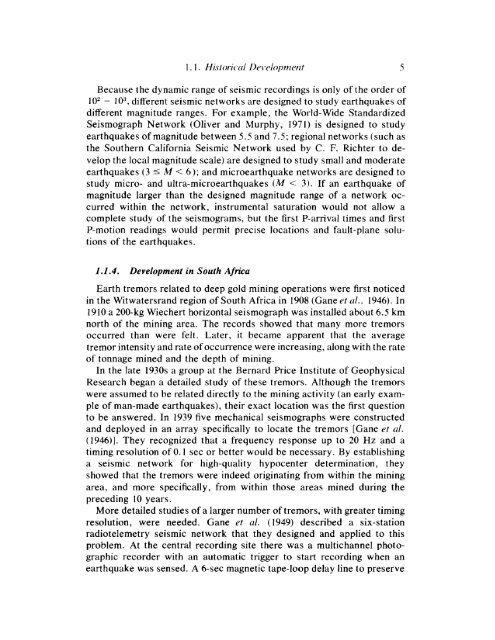principles and applications of microearthquake networks
principles and applications of microearthquake networks
principles and applications of microearthquake networks
Create successful ePaper yourself
Turn your PDF publications into a flip-book with our unique Google optimized e-Paper software.
I. 1. Histot-icd Development 5<br />
Because the dynamic range <strong>of</strong> seismic recordings is only <strong>of</strong> the order <strong>of</strong><br />
10' - lo3, different seismic <strong>networks</strong> are designed to study earthquakes <strong>of</strong><br />
different magnitude ranges. For example, the World-Wide St<strong>and</strong>ardized<br />
Seismograph Network (Oliver <strong>and</strong> Murphy, 1971) is designed to study<br />
earthquakes <strong>of</strong> magnitude between 5.5 <strong>and</strong> 7.5; regional <strong>networks</strong> (such as<br />
the Southern California Seismic Network used by C. F. Richter to develop<br />
the local magnitude scale) are designed to study small <strong>and</strong> moderate<br />
earthquakes (3 5 A4 < 6); <strong>and</strong> <strong>microearthquake</strong> <strong>networks</strong> are designed to<br />
study micro- <strong>and</strong> ultra-<strong>microearthquake</strong>s (M < 3). If an earthquake <strong>of</strong><br />
magnitude larger than the designed magnitude range <strong>of</strong> a network occurred<br />
within the network, instrumental saturation would not allow a<br />
complete study <strong>of</strong> the seismograms, but the first P-arrival times <strong>and</strong> first<br />
P-motion readings would permit precise locations <strong>and</strong> fault-plane solutions<br />
<strong>of</strong> the earthquakes.<br />
1 .I .4.<br />
Development in South Africa<br />
Earth tremors related to deep gold mining operations were first noticed<br />
in the Witwatersr<strong>and</strong> region <strong>of</strong> South Africa in 1908 (Gane et al., 1946). In<br />
1910 a 200-kg Wiechert horizontal seismograph was installed about 6.5 km<br />
north <strong>of</strong> the mining area. The records showed that many more tremors<br />
occurred than were felt. Later, it became apparent that the average<br />
tremor intensity <strong>and</strong> rate <strong>of</strong> occurrence were increasing, along with the rate<br />
<strong>of</strong> tonnage mined <strong>and</strong> the depth <strong>of</strong> mining.<br />
In the late 1930s a group at the Bernard Price Institute <strong>of</strong> Geophysical<br />
Research began a detailed study <strong>of</strong> these tremors. Although the tremors<br />
were assumed to be related directly to the mining activity (an early example<br />
<strong>of</strong> man-made earthquakes), their exact location was the first question<br />
to be answered. In 1939 five mechanical seismographs were constructed<br />
<strong>and</strong> deployed in an array specifically to locate the tremors [Gane et al.<br />
(1946)]. They recognized that a frequency response up to 20 Hz <strong>and</strong> a<br />
timing resolution <strong>of</strong> 0.1 sec or better would be necessary. By establishing<br />
a seismic network for high-quality hypocenter determination, they<br />
showed that the tremors were indeed originating from within the mining<br />
area, <strong>and</strong> more specifically, from within those areas mined during the<br />
preceding 10 years.<br />
More detailed studies <strong>of</strong> a larger number <strong>of</strong> tremors, with greater timing<br />
resolution, were needed. Gane et af. (1949) described a six-station<br />
radiotelemetry seismic network that they designed <strong>and</strong> applied to this<br />
problem. At the central recording site there was a multichannel photographic<br />
recorder with an automatic trigger to start recording when an<br />
earthquake was sensed. A 6-sec magnetic tape-loop delay line to preserve






